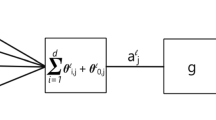Abstract
An expert system has been developed for the initial analysis of a recorded spectrum, namely, for the line search and the determination of line positions and intensities. The expert system is based on pattern recognition algorithms. Object recognition learning allows the system to achieve the needed flexibility and automatically detect groups of overlapping lines, whose profiles should be fit together. Gauss, Lorentz, and Voigt profiles are used as model profiles to which spectral lines are fit. The expert system was applied to processing of the Fourier transform spectrum of the D2O molecule in the region 3200–4200 cm−1, and it detected 4670 lines in the spectrum, which consisted of 439000 dots. No one experimentally observed line exceeding the noise level was missed.
Similar content being viewed by others
References
R. A. Toth, L. R. Brown, and C. Plymate, J. Quant. Spectrosc. Radiat. Transf. 59, 529 (1998).
M. A. Aĭzerman, É. I. Braverman, and L. I. Rozonoér, Potential Function Method in Problems of Machine Teaching (Nauka, Moscow, 1970).
L. L. Levin, Introduction to the Pattern Recognition Theory (Tomsk. Gos. Univ., Tomsk, 1982).
A. P. Shcherbakov, Opt. Atmos. Okeana 10, 947 (1997).
A. M. Pshenichnikov and A. P. Shcherbakov, Proc. SPIE 4143, 60 (2000).
A. D. Bykov, O. N. Naumenko, L. N. Sinitsa, et al., Opt. Spektrosk. 94, 580 (2003) [Opt. Spectrosc. 94, 528 (2003)].
P. Jensen, The Giessen Program for Processing Spectral Data from BRUKER IFS 120 HR Interferometer Using an IBM Compatible Personal Computer (Justus Leigig Univ., Giessen, 1990).
M. Birk, D. Hausamann, G. Wagner, and J. W. Johns, Appl. Opt. 35, 2971 (1996).
M. E. Élyashberg, L. A. Gribov, and V. V. Serov, Molecular Spectral Analysis and Computers (Nauka, Moscow, 1980).
M. Yu. Kataev and A. A. Mitsel’, Avtometriya, No. 4, 15 (1985).
M. Yu. Kataev, A. A. Mitsel’, and S. R. Tarasova, Opt. Atmos. 3, 832 (1990).
A. N. Tikhonov and V. Ya. Arsenin, Solutions of Ill-Posed Problems (Nauka, Moscow, 1974; Halsted, New York, 1977).
A. Bykov, O. Naumenko, L. Sinitsa, et al., J. Mol. Struct. 199, 158 (2000).
Author information
Authors and Affiliations
Additional information
__________
Translated from Optika i Spektroskopiya, Vol. 96, No. 4, 2004, pp. 552–558.
Original Russian Text Copyright © 2004 by Bykov, Pshenichnikov, Sinitsa, Shcherbakov.
Rights and permissions
About this article
Cite this article
Bykov, A.D., Pshenichnikov, A.M., Sinitsa, L.N. et al. Application of pattern recognition in molecular spectroscopy: Automatic line search in high-resolution spectra. Opt. Spectrosc. 96, 497–502 (2004). https://doi.org/10.1134/1.1719135
Received:
Published:
Issue Date:
DOI: https://doi.org/10.1134/1.1719135




